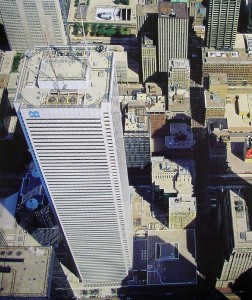
From skyscrapercity.com
It can happen – a power failure that blacks out your building or your offices. What would you do?
First Canadian Place, shown here, went black for an entire day from about 7:30am to 4:30pm on October 14th, 2010.
It’s a 44 story, 2.7 million sq.ft. building in the heart of Toronto’s financial district.
While the building has emergency backup power for life safety, companies leasing space in the building could only rely on their short-lived UPS power and eventually sent people home. Even the Tim Hortons, a very popular Canadian coffee outlet located in the retail level, went dark. Located in the financial core with a major retail concourse and as part of Toronto’s underground PATH network where people can go from building to building through underground pathways lined with retail shops, the property owner estimates that 84,000 people work in or go through the building every day.
The spokesman for the property owner noted that a number of business lacked the power they needed to run lights, computers and other office equipment. No surprise. Backup power for most organizations only enables an orderly shutdown of systems to prevent lost data, not to run operations for a full day. Few are prepared for extended blackouts.
The question is, how prepared is your organization? With alternate work arrangements and technology, many employees could actually work from a different location or even from home, but so many other roles rely on technology, services, phone systems, files and more that are only available in the office. If you have customers trying to reach you or need things done right away, you have a potential problem. In this global economy, they probably don’t know you are having an emergency, and may not even feel it’s a legitimate excuse. They just know you let them down. That can affect your organization’s reputation and even the bottom line.
If you are responsible for your offices, what have you done to develop contingency plans if facilities aren’t available and what has your organization done to enable the core business to continue functioning? Developing facility contingency plans and Business Continuity Plans (BCP) should be a priority. I like the plain language on Wikipedia: “BCP is working out how to stay in business in the event of disaster.”
Even if BCP isn’t your responsibility, ask those who are responsible what their plans are and how your contingency plans fit into the overall organization’s plans. Work with them to ensure you are providing both full support to the organization as well as playing a leading role, not a reactionary role to support your organization in the case of an emergency. And beyond facility contingency plans, develop your own BCP to make sure your own Facilities Department has plans that enable you to respond and continue providing the services your organization needs in the case of a disaster.





